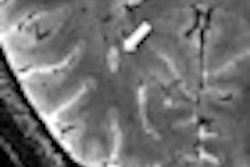SAN FRANCISCO - A controversial theory that vascular blockages cause multiple sclerosis (MS) found additional support this week at the Society of Interventional Radiology (SIR) annual meeting. Researchers showed that using vascular angioplasty to clear blocked veins also quelled some MS symptoms.
Multiple sclerosis has long been considered an autoimmune disorder, though its etiology has never been precisely identified. It is a progressive, highly debilitating neurological condition that attacks the brain, spine, and optic nerves. The disease manifests itself in a range of symptoms, including diminished vision, motor skills, sensory sensation, bowel and bladder control, sexual performance, and cognition.
Theories proposing a vascular cause for MS were discussed in the 19th and 20th centuries, noted Dr. Kenneth Mandato during a news conference on Sunday at the SIR meeting. The concept reappeared in 2009 in clinical studies by Italian vascular surgeon Dr. Paolo Zamboni.
Using ultrasound and catheter-based venography, Zamboni identified a high prevalence of venous insufficiency in the internal jugular and azygos veins of MS patients. The vessels feed deoxygenated blood from the brain and spine to the heart and lungs. Zamboni coined the term chronic cerebrospinal venous insufficiency (CCSVI) to describe the stenotic vascular condition.
His findings initially caused a public sensation, with desperate MS patients seeking endovascular stenting procedures to affect a cure. At least two deaths and several injuries were attributed to unsuccessful procedures.
Imaging strengthens the connection
Still, subsequent inquiries by other researchers with Doppler ultrasound and 3-tesla MR venography have strengthened the connection between MS and CCSVI. Recent studies by Dr. Robert Zivadinov of the University of Buffalo and Dr. Marcello Mancini of the University of Naples in Italy found a significantly higher prevalence of CCSVI among MS patients than healthy adults (Neurology, 2011, Vol. 77:2, pp. 138-144; Radiology, 2012, Vol. 262:3, pp. 947-955).
At the 2011 SIR meeting, Mandato and collaborating interventional radiologists at Albany Medical Center presented a retrospective analysis based on case experience with 240 patients demonstrating the safety of balloon angioplasty to treat CCSVI. The study, published in the Journal of Vascular and Interventional Radiology in January, concluded that the condition can be treated with a 1.6% risk of major complications (JVIR, 2012, Vol. 23:1, pp. 55-59).
At this year's SIR conference, Dr. Hector Ferral, an interventional radiologist at NorthShore University Hospital in Evanston, IL, described experience with 105 procedures confirming the prevalence of CCSVI among MS patients and the safety of angioplasty to treat the condition. Venography and intravascular ultrasound detected stenosis in 94.9% of MS patients.
Angioplasty was performed on 179 abnormal veins, with stent placement required in five veins. Symptomatic improvement was reported by 54% of patients. Questionable improvement was described in interviews with 17%, and no improvement was described by 29% of those treated, Ferral said.
The Albany group reappeared this week with its own new study, suggesting that CCSVI may relieve symptoms of MS as well. To reach that conclusion, Mandato and colleagues had 192 MS patients complete standardized Multiple Sclerosis Quality of Life (MSQOL-54) surveys measuring their assessment of their physical and mental health before and an average of 109 days after CCSVI treatment.
The retrospective review found that the physical health scores of the patients improved, from an average of 43 before treatment to 52 after therapy. Their mental health scores improved from 57 to 65. Both changes were statistically significant (p < 0.05).
Compared with patients with secondary-progressive MS, patients with primary-progressive and relapsing-remitting MS reported a relatively greater reduction in their symptoms, with more than an average 75% improvement in their physical health scores and 70% improvement in their average mental health scores.
Fifty-nine percent of patients with secondary-progressive disease saw an improvement following treatment. Half improved their mental health scores, according to Dr. Meridith Englander, an interventional radiologist and co-author of the study.
The amount of reported improvement also depended on disease duration. Physical health scores improved for seven of 10 patients who had been diagnosed with MS for fewer than 10 years. Mental health scores rose for nearly eight of 10. For patients who had MS for more than 10 years, 66% saw their physical health scores improve, and 60% had better mental health scores.
Many of the improvements represented small steps toward independent living, Englander noted. In one instance, a wheelchair-bound patient regained the ability to transfer to a chair. Others were able to stand and pull on their own pants.
"Little things like that are significant," she said.
Placebo effect?
Critics argue, however, that the apparent clinical benefits of CCSVI treatment for MS patients has more to do with a placebo effect than the medical benefits of venous revascularization. Others question physiological evidence proposing a correlation between venous congestion in the neck and chest and the manifestations of MS in the brain.
Dr. David Kumpe, director of interventional neuroradiology at the University of Colorado, told AuntMinnie.com that researchers have yet to establish how much intracranial venous pressure CCSVI generates or what happens to pressure above and below the stenoses before and after treatment.
Even the likelihood of increased intracranial pressure seems suspicious, according to Kumpe, because characteristic symptoms, such as headaches, elevated opening pressures on lumbar punctures, and papilledema, have not been observed.
"Maybe there is something going on," he said. "If that is the case, then they are right but for the wrong reason."



















